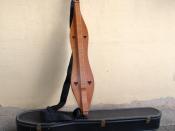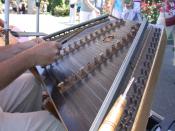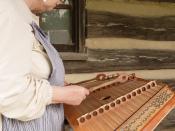ORIGINS AND HISTORY OF THE DULCIMER
The dulcimer is a member of the string family. It is further categorized into the Psaltrey family, a group of instruments that are comprised of strings stretched across a frame and played by plucking or drumming. The only difference, in fact, between the dulcimer and the psaltrey is the fact that one is plucked and the other is drummed. The dulcimer family is divided into two sections. The dulcimers with keys and dulcimers without keys. A dulcimer with keys would be played by depressing a key which would move a mechanism that would cause a hammer to strike the string. The most improved instrument in the keyed dulcimer section is the piano. Dulcimers that are played without the aid of a key are usually in the unusual shape of a trapezoid. Early descriptions of this instrument, dating back to the Middle Ages, describe the instrument as a rectangular box with strings stretched over two bridges.
Both the single and the double bridged dulcimers are common in traditional Irish music. It is played by striking the strings with padded wooden hammer.
It is commonly believed that the dulcimer came to Europe from the East sometime in the fifteenth century. This cannot be true. The dulcimer is closely related to the yang ch'in from China. However, the yang ch'in was introduced to the Chinese around 1800. A similar traditional dulcimer found its way to Korea in about 1725. The dulcimer originated as the santir in what is now Iraq from a Greek instrument, the psalterion. The santir was a trapeziodal box covered with strings. It was played by striking the strings with light sticks. From there the Arabs carried the santir through North Africa where it was integrated into the Jewish culture. From North Africa...



History and Origins of the Dulcimer
I enjoyed reading this essay. It is a "fast" and esay reading essay with good descriptions. I do not get confused when reading the descriptions of the different dulcimers. And the history is very clear and precise.
10 out of 10 people found this comment useful.